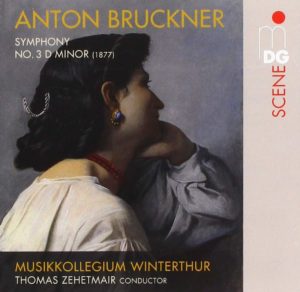I wouldn’t rule out that a small orchestra with something to say can’t do invigorating romantic music—even Bruckner. Thomas Dausgaard’s Bruckner Second comes to mind, where the incense-free très sportif atmosphere does its part to bring out Bruckner’s kinship with Schubert. So when Thomas Zehetmair (whose musicianship as a violinist and string quartet player is of the very highest order) recorded Bruckner’s Third symphony with his Musikkollegium Winterthur (which itself has some very nice recordings of Frank Martin and, for that matter, Schubert, to its name), my expectations weren’t particularly low, though not particularly high, either. But at least my curiosity was definitely piqued. Going into the game with that handicap of so-so expectations, the recording comes out just about at par. It’s okay. But measuring up against, say, Guiseppe Sinopoli/Dresden (DG) or Bernard Haitink/Vienna (Philips), both of them Bruckner Pros that are easily scratch and also perform the 1877 version, that’s ultimately weak tea.
Disappointingly there’s not a whole lot else to say about the actual performance: The well-intentioned Musikkollegium Winterthur is—along with the Dresden Staatskapelle—one of the oldest continuously existing orchestras in the world. For all its history, it doesn’t sound like the latter, and that’s the first strike against it.
The quicksilver opening belies the misterioso atmosphere that might evoke Beethoven’s Ninth—and makes little of the contrast to the following “quasi allegro”. The horn playing is fine and the entire brass section, for better or worse, sounds very distinctive. Good spatial separation means you can hear every individual instrument: Nouvelle cuisine to Karajan’s (1889) all-flavors-in-one-pot stew. “Thin gruel” might be a less kindly description. That’s not bad, per se, but most listeners and Bruckner-lovers are used to musical phrases having a certain weight in Bruckner.
The usually powerful finale of the first movement (which recalls the opening theme in this version) is one of those literally awesome moments in Bruckner: here, it’s more like “phffffft”, like air escaping a balloon. There is no mass that accumulates. The orchestra never brings any weight to the music, even if you turn the volume up, which you have to, because the recording levels are pretty low. In fact, you really need to crank this recording up for it to make any sense, in which case the considerable dynamic range of the recording (laudable in and of itself) might upset the neighbors at a climax or two. (Philosophical question: is a neighbor who doesn’t love Bruckner worth not upsetting?)
The opening of the brisk Andante is beautifully light, but later on the strings’ clumsy see-sawing motion is ungainly. Dancing figures (such as in the Scherzo and Finale) are generally pleasing but amount to little in a finale with substance a bit like a runny egg. The nervous energy in the run-up to the last bars sounds as though Bruckner himself was conducting, and terribly worried about the bad reception he is about to get. It makes for a very unmemorable moment. The violins are scrawny on too many occasions. There’s very little beauty to the sound and the lack of beauty is not ideological-intentional, it’s just a lack of quantity and quality among the strings to attain a better result.
The recording itself—very transparent despite reverb; bright bordering harsh—is (at least on the stereo SACD layer) unusually unsatisfactory for an MDG production. Come to think of it, the more I listen to the recording, the less I like it. I’ve changed my mind: No matter what handicap you give it, it’s just not competitive.
































